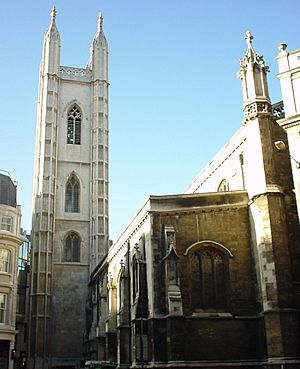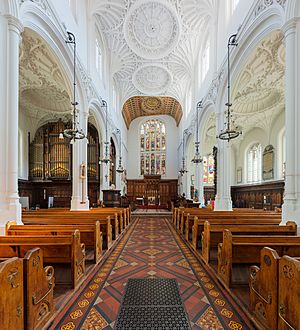St Mary Aldermary facts for kids
Quick facts for kids Guild Church of St Mary Aldermary |
|
|---|---|
| Guild Church of St Mary Aldermary | |

St Mary Aldermary Church view from Queen Victoria Street
|
|
| Location | London, EC4 |
| Country | United Kingdom |
| Denomination | Church of England |
| Previous denomination | Roman Catholicism |
| Architecture | |
| Heritage designation | Grade I listed building |
| Architect(s) | Office of Christopher Wren |
| Style | Gothic |
| Years built | 1681 |
| Administration | |
| Diocese | London |
St Mary Aldermary is an Anglican church in the City of London, United Kingdom. You can find it on Bow Lane where it meets Watling Street.
This church has a long history, going back to medieval times. Building a new church started in 1510 and took a very long time, finally finishing in 1632. Just 33 years later, in 1666, a huge event called the Great Fire of London badly damaged it. The famous architect Sir Christopher Wren's team then rebuilt it. Unlike most of Wren's churches, St Mary Aldermary was rebuilt in a Gothic style, which means it looked like older medieval churches.
In 1952, the church's role changed. It became a guild church, which means it serves people who work in the City of London but don't live there. Today, the main part of the church is a public cafe during weekdays. It also holds religious and quiet meditation sessions in the mornings and evenings.
Contents
History of St Mary Aldermary
A church has stood on this spot for over 900 years! Its name, "Aldermary," probably means it's the oldest church in the City of London named after the Virgin Mary. Some also think it means it's older than the nearby St Mary Le Bow church. For a long time, the right to choose the church's priest belonged to the Archbishop of Canterbury.
Building the Medieval Church
In 1510, Sir Henry Keeble, a powerful leader in London, paid for a new church to be built. The church tower was not finished when he passed away in 1518. However, in 1629, money from two gifts allowed the tower to be completed. The building work, which had started 120 years earlier, was finally finished within three years.
Sir Henry Keeble was buried under the church floor. But his grave was later moved. Other important people, like Sir William Laxton and Sir Thomas Lodge, were buried there instead. Their monuments replaced his.
Many important people were buried in the early church. John Stow wrote about them in his 1598 book, Survey of London. He mentioned Richard Chaucer, who was said to be the father of the famous poet Geoffrey Chaucer. Also, the poet John Milton married his third wife, Elizabeth Minshull, in this church in 1663.
The church's records of births, marriages, and deaths began in 1558. These old records are now kept at the Guildhall Library.
In 1599, a group from another church, St. Antholin's, started a daily lecture series. They used property in London to pay for these talks. St. Antholin's became famous for these lectures. When the Great Fire burned down St. Antholin's, the lectures continued. After St. Antholin's was demolished in 1870, the lectures moved to St. Mary Aldermary. Today, the Church Society organizes these lectures.
Rebuilding After the Great Fire
The Great Fire of London in 1666 severely damaged St Mary Aldermary. However, some parts of its walls and tower survived. The church was mostly rebuilt by the team of Sir Christopher Wren. A man named Henry Rogers had left £5,000 in his will to rebuild a church. His widow agreed to use this money for St Mary's. Some stories say she insisted the new church look exactly like the old one that was destroyed.
The rebuilt church has a main area called a nave, with side sections called aisles. It has a short chancel, which is the area near the altar. The tower is at the south-west corner and you enter it through a lobby. The tower has different levels marked by stone bands. Its corners have eight-sided turrets at the top. Inside, the nave and aisles are separated by arches supported by groups of columns. The ceilings are beautifully decorated with plaster fan vaulting, which looks like a fan.
According to an expert named Nikolaus Pevsner, St Mary Aldermary is a very important example of the "Gothic revival" style from the 1600s in London. It's one of the most important Gothic churches from that time in England.
The parish of another church, St Thomas the Apostle, was also destroyed in the Great Fire and not rebuilt. Its area was joined with St Mary's.
In 1781, a new organ was put in the church. It was built by George England.
Damage During Wartime
St Mary Aldermary was damaged by German bombs during the London Blitz in the Second World War.
Church Restorations
The church has been repaired and updated many times over the years. In 1876–77, big changes were made inside. An oak screen was added to separate the lobby from the main church. The seating was replaced, and the organ was moved. The floor was redone, new stained glass was put in the windows, and a new reredos (a screen behind the altar) was installed.
The church was officially recognized as a Grade I listed building on January 4, 1950. This means it's a very important historic building.
The most recent interior restoration finished in April 2005. Workers carefully cleaned and repaired the plaster ceilings and the memorials on the north wall. A special service was held on April 21, 2005, led by Richard Chartres, the Bishop of London, to celebrate the completion of the work.
Recent Activities and Community
In January 2010, the Bishop and Archdeacon of London invited the Moot Community to make St Mary Aldermary their home. Moot was a Church of England group that focused on spiritual practices like prayer and meditation. They also valued acceptance, balance, creativity, and being welcoming.
As of 2025, services in a similar style are still held. These include silent meditation on Monday mornings, and Taize (a type of meditative singing) on Wednesday and Friday mornings. On Wednesday evenings, there's a "Still Point contemplation" session.
In 2012, Moot opened a cafe called Host. It still sells fair trade coffee and other goods.
Since 2007, St Mary Aldermary has been the Regimental Church for the Royal Tank Regiment. This means it has a special connection to this army unit.
The church also hosts the Moldovan Orthodox church in London, which calls the building St Nicholas.
Before this, St Mary Aldermary hosted the Malankara Orthodox Syrian congregation. Their church, St Gregorios, combined South Indian worship styles with ancient Syriac traditions.
See also


